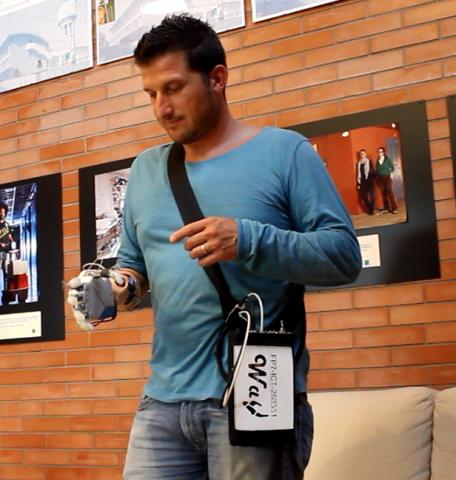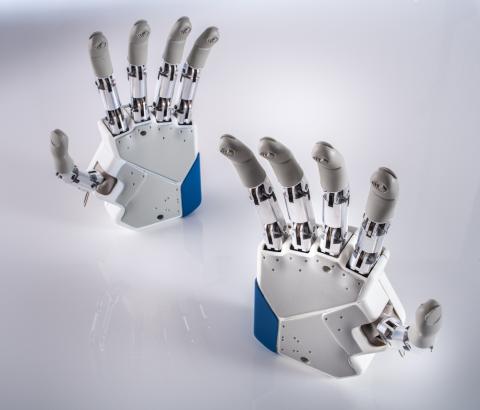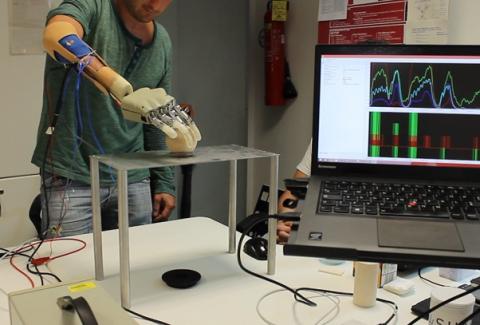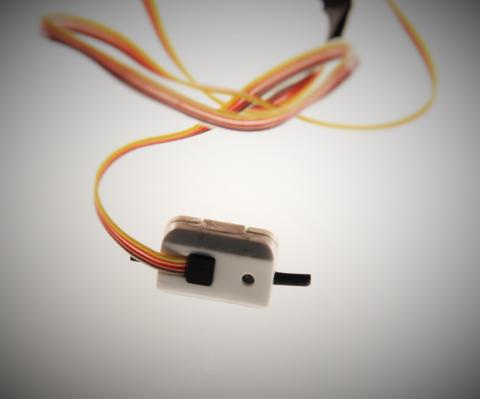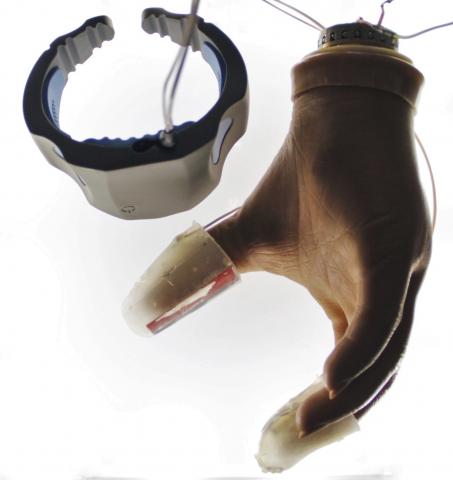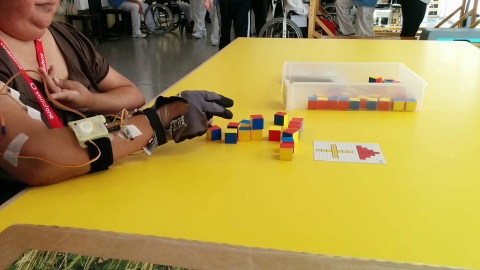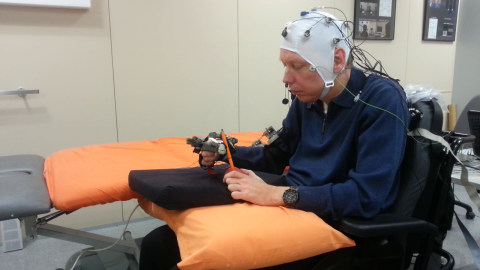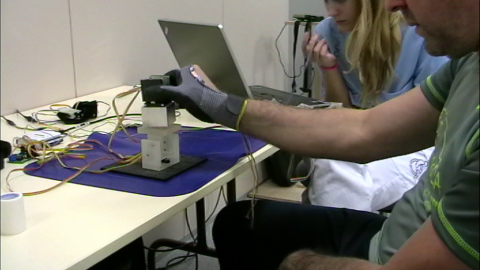WAY - Wearable interfaces for hand function recovery
The skilful motor and sensory functions of our hands cannot be given for granted, as traumatic amputations or neurological injuries may severely compromise them. For example in the European community every year there are ~2,000 new hand amputations and about 7,500 new spinal cord injuries – of which a significant percentage affect hand function. For this reason functional substitution as well as recovery of the sensorimotor capacities of the human hand represents one of the major goals in applied neuroscience and bioengineering, faced worldwide by scientists and engineers.
Among these efforts, WAY, was a collaborative research project coordinated by Dr. Cipriani at the Scuola Sant’Anna and funded by the European Commission under the 7th Framework Programme for research and technological development (FP7-ICT-288551; October 2011 - May 2015) with 2.25 M€. WAY proposed wearable (non-invasive) human-machine interfaces and robotic hand assistive devices, like robotic hand prostheses or exoskeletons, in order to improve the quality of life of individuals with amputation or neurological injuries. Thus WAY faced two clinical scenarios: the first one focusing on upper limb amputees fitted with a dexterous hand prosthesis, the second one targeting individuals with limited hand function and sensibility, due to SCI, whom motor and sensory functions could be recovered by means of a wearable robotic exoskeleton.
Besides the AHA and the Neuro Robotics Area (in particular the Wearable Robotics Lab), WAY Consortium was composed by six partners from six countries in Europe: Umea University, Tubingen University, Scuola Universitaria Professionale della Svizzera Italiana IDSIA, Institut Guttmann, Ossur. The outcomes of WAY are nicely presented in the video at the bottom of this page.
Funder: European Commission
Grant No.: 288551
Period: 2011-2015 (44 months)
Funding (to AHA): 600 k€
Funding (total): 2.25 M€
Scientific Publications
Journal papers
- I. Strazzulla, M. Nowak, M. Controzzi, C. Cipriani, C. Castellini, Online Bimanual Manipulation Using Surface Electromyography and Incremental Learning” IEEE Trans. on Neural Systems and Rehabilitation Engineering, vol. 25, no. 3, pp. 227-234, 2017 (on line version 2016);
- H. Al-Angari, G. Kanitz, S. Tarantino, C. Cipriani, Distance and Mutual Information Methods for EMG Feature and Channel Subset Selection for Classification of Hand Movements, Biomedical Signal Processing and Control, vol. 27, pp. 24-31, 2016;
- F. Clemente, M. D’Alonzo, M. Controzzi, B. Edin, C. Cipriani, Non-invasive, temporally discrete feedback of object contact and release improves grasp control of closed-loop myoelectric transradial prostheses, IEEE Trans. on Neural Systems and Rehabilitation Engineering, vol. 34, no. 12, pp. 1314-1421, 2016 (on line version 2015);
- S. Crea, M. D’Alonzo, N. Vitiello, C. Cipriani, The rubber foot illusion, Journal of NeuroEngineering and Rehabilitation, vol. 12, no. 77, 2015;
- S. Crea, C. Cipriani, M. Donati, M. C. Carrozza, N. Vitiello, Providing time-discrete gait information by wearable feedback apparatus for lower-limb amputees: usability and functional validation, IEEE Trans. on Neural Systems and Rehabilitation Engineering, vol. 23, no. 2, pp.250-257, 2015;
- J.L. Segil, M. Controzzi, R.F. Weir, C. Cipriani, Comparative study of State of the Art Myoelectric Controllers for Advanced Prosthetic Hands using Virtual and Physical Assessment, Journal of Rehabilitation Research & Development, vol. 51, no.9, pp. 1439-1454, 2014;
- M. D'Alonzo, F. Clemente, C. Cipriani, Vibrotactile stimulation promotes embodiment of an alien hand in amputees with phantom sensations, IEEE Trans. on Neural Systems and Rehabilitation Engineering, vol. 23, no. 3, pp. 450-457, 2015. (Online version 2014); Featured article
- C. Cipriani, J. Segil, F. Clemente, R. Weir, B. Edin, Humans can integrate feedback of discrete events in their sensorimotor control of a robotic hand, Experimental Brain Research, vol. 232, no. 11, pp. 3421-3429, 2014;
- C. Cipriani, J. Segil, A. Birdwell, R. Weir, Dexterous control of a prosthetic hand using fine-wire intramuscular electrodes in targeted extrinsic muscles, IEEE Trans. on Neural Systems and Rehabilitation Engineering, vol. 22, no. 4, pp. 828-836, 2014. Video pdf - Special issue on advances in control of multi-functional powered upper-limb prostheses. Featured article
- M. D’Alonzo, S. Dosen, C. Cipriani, D. Farina, HyVE – Hybrid Vibro-Electrotactile Stimulation – is an Efficient Approach to Multi-Channel Sensory Feedback, IEEE Transactions on Haptics, vol. 7, no. 2, pp. 181-190, 2014 (on line version 2013); pdf
- M. D'Alonzo, S. Došen, C. Cipriani, D. Farina, HyVE: Hybrid Vibro-Electrotactile Stimulation for Sensory Feedback and Substitution in Rehabilitation, IEEE Trans. on Neural Systems and Rehabilitation Engineering, vol. 22, no. 2, pp. 290-301, 2014 (online version 2013). download pdf
- P. Rogério de Almeida Ribeiro, F. Lima Brasil, M. Witkowski, F. Shiman, C. Cipriani, N. Vitiello, M. C. Carrozza, S. R. Soekadar, "Controlling assistive machines in paralysis using brain waves and other biosignals," Advances in Human-Computer Interaction, vol. 13, ID 369425, 2013. pdf Special issue on using brain waves to control computer and machines
- Y. Hao, M. Controzzi, C. Cipriani, D. B. Popovic, X. Yang, W. Chen, X. Zheng, M.C. Carrozza,"Controlling Hand-Assistive Devices: Utilizing Electrooculography as a Substitute for Vision" IEEE Robotics and Automation Magazine, vol. 20, no. 1, pp. 40-52, 2013. pdf Special issue on Assistive robotics
- C. Antfolk, M. D’Alonzo, M. Controzzi, G. Lundborg, B. Rosén, F. Sebelius, C. Cipriani, "Artificial redirection of sensation from prosthetic fingers to the phantom hand map on transradial amputees: vibrotactile vs mechanotactile sensory feedback discrimination," IEEE Trans. on Neural Systems and Rehabilitation Engineering, vol. 21, no. 1, pp. 112-120, 2013 (online version 2012). pdf
- C. Antfolk, M. D’Alonzo, B. Rosén, G. Lundborg, F. Sebelius, C. Cipriani, "Sensory feedback in upper limb prosthetics," Expert Review of Medical Devices, vol. 10, no.1, pp. 45-54, 2013. pdf Download
- M. D’Alonzo and C. Cipriani, “Vibrotactile sensory substitution elicits feeling of ownership of an alien hand,” PLOS ONE, vol. 7, no. 11, pp. 1-9, 2012. Download
Conference papers
- H. Alangari, G. Kanitz, S. Tarantino, J. Rigosa, C. Cipriani, “Feature and Channel Selection using Correlation Based Method for Hand Posture Classification in Multiple Arm Positions,” International Conf. on NeuroRehabilitation, ICNR, Aalborg, Denmark, Jun. 24-26, 2014.
- F. Clemente and C. Cipriani, “A novel device for multi-modal sensory feedback in hand prosthetics: design and preliminary prototype,” In Proc. of IEEE Haptics Symposium, Houston, TX, Feb. 23-26, 2014.

